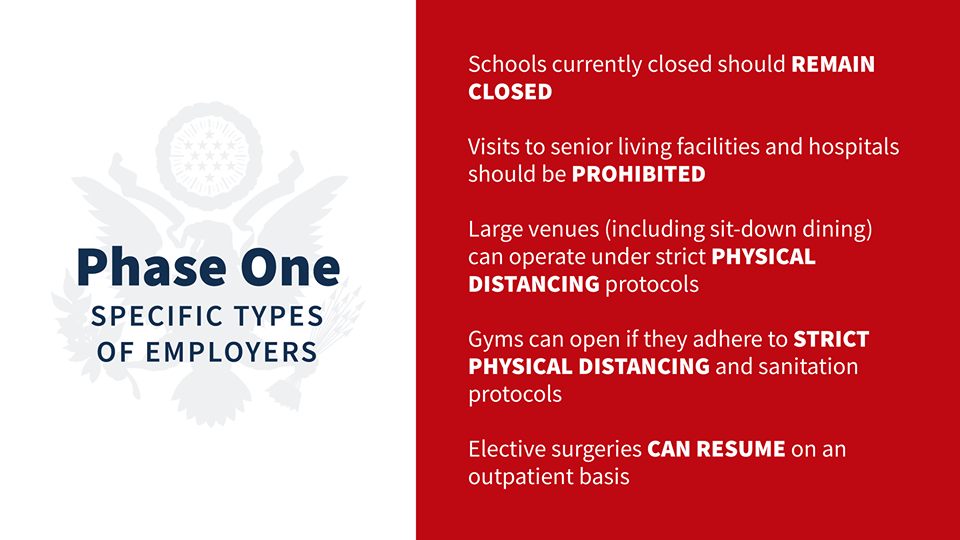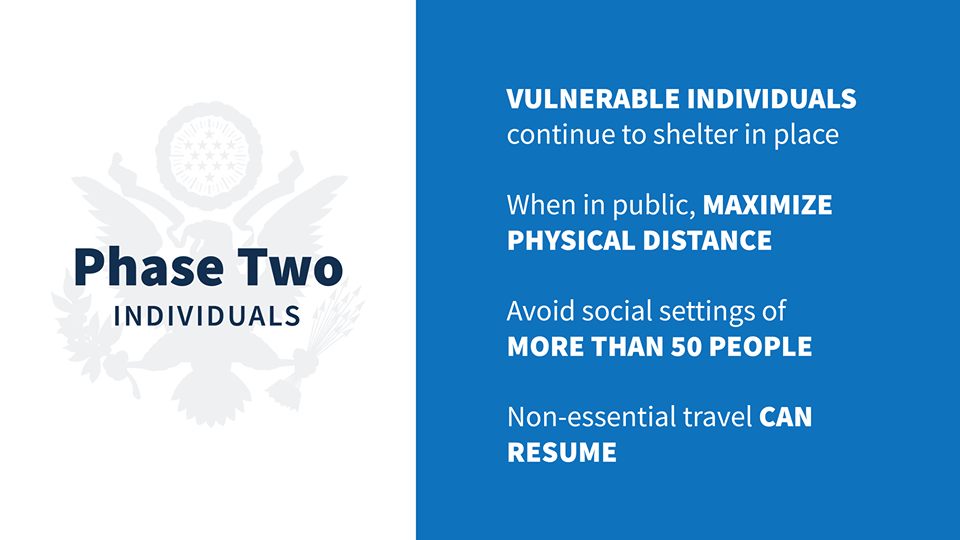President Donald Trump has unveiled Guidelines for “Opening Up America Again,” a three-phased approach based on the advice of public health experts. These steps will help state and local officials when reopening their economies, getting people back to work, and continuing to protect American lives from COVID-19.
Phase One
Phase one of the Opening Up America Again plan for states and regions that satisfy the gating criteria includes:
Individuals
- All vulnerable individuals should continue to shelter in place. Members of households with vulnerable residents should be aware that by returning to work or other environments where distancing is not practical, they could carry the virus back home. Precautions should be taken to isolate from vulnerable residents.
- All individuals, when in public(e.g., parks, outdoor recreation areas, shopping areas), should maximize physical distance from others. Social settings of more than 10 people, where appropriate distancing may not be practical, should be avoided unless precautionary measures are observed.
- Avoid socializing in groups of more than 10 people in circumstances that do not readily allow for appropriate physical distancing (e.g., receptions, trade shows)
- Minimize non-essential travel and adhere to CDC guidelines regarding isolation following travel.
Employers
- Continue to encourage telework whenever possible and feasible with business operations.
- If possible, return to work in phases.
- Close common areaswhere personnel are likely to congregate and interact, or enforce strict social distancing protocols.
- Minimize non-essential travel and adhere to CDC guidelines regarding isolation following travel.
- Strongly consider special accommodations for personnel who are members of a vulnerable population.
Specific Types of Employers

- Bars should also remain closed.
Phase Two
Then, phase two of the Opening Up American Again plan for states and regions with no evidence of a rebound and that satisfy the gating criteria a second time includes:
Individuals

- Members of households with vulnerable residents should be aware that by returning to work or other environments where distancing is not practical, they could carry the virus back home. Precautions should be taken to isolate from vulnerable residents.
Employers
- Continue to encourage telework, whenever possible and feasible with business operations.
- Close common areas where personnel are likely to congregate and interact, or enforce moderate social distancing protocols.
- Strongly consider special accommodations for personnel who are members of a vulnerable population.
Specific Types of Employers
- Schools and organized youth activitites (e.g., daycare, camp) can reopen.
- Visitors to senior care facilities and hospitals should be prohibited. Those who do interact with residents and patients must adhere to strict protocols regarding hygiene.
- Large venues (e.g., sit-down dining, movie theaters, sporting venues, places of worship) can operate under moderate physical distancing protocols.
- Elective surgeries can resume, as clinically appropriate, on an outpatient and in-patient basis at facilities that adhere to CMS guidelines.
- Gyms can remain open if they adhere to strict physical distancing and sanitation protocols.
- Bars may operate with diminished standing-room occupancy, where applicable and appropriate.
Phase Three
Finally, phase three of the Opening Up America Again plan for states and regions with no evidence of a rebound and that satisfy the gating criteria a third time includes:
Individuals
- Vulnerable individuals can resume public interactions, but should practice physical distancing, minimizing exposure to social settings where distancing may not be practical, unless precautionary measures are observed.
- Low-risk populations should consider minimizing time spent in crowded environments.
Employers
- Resume unrestricted staffing of worksites.
Specific Types of Employers
- Visitors to senior care facilities and hospitals can resume. Those who interact with residents and patients must be diligent regarding hygiene.
- Large venues (e.g., sit-down dining, movie theaters, sporting venues, places of worship) can operate under limited physical distancing protocols.
- Gyms can remain open if they adhere to standard sanitation protocols.
- Bars may operate with increased standing room occupancy, where applicable.





